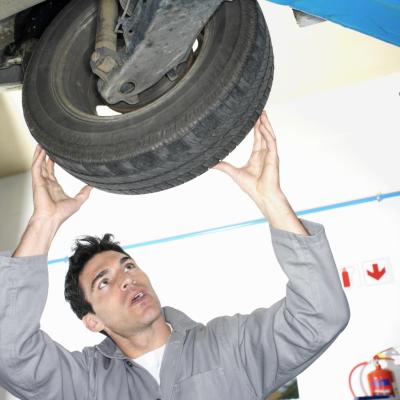
The entire weight of an automobile frame and body is suspended above the wheels by springs. Vertical independent motion of the wheels is necessary to maintain vehicle road traction and heading, regardless of driving surface irregularities. Without some method to control spring exertions, a car would continue bobbing long after some surface infraction was encountered. Shock absorbers limit such flexing and restrict other spring qualities that can adversely affect the steering of a vehicle.
When a spring is compressed, it tends by nature to push against the compressing load, or weight. In automotive applications, the spring attempts to rebound to a normal height, called ride height. The momentum of the repelled load carries it beyond ride height, and the load is deflected. Returning load inertia in the opposite direction compresses the spring past normal height, and the process continues until spring strength overcomes the momentum of the mass. The time and distance traveled by a spring in returning to an original state is the frequency for that spring. Strength rates and frequencies of springs are carefully calibrated by design to yield the desired characteristics for a particular application. Shock absorber capabilities are matched to these specific spring rates.
Shock absorbers reduce spring oscillations to aid in quick, even returns to normal ride height. A vehicle with weak or defective shocks can transfer weight loads fore and aft, or side-to-side, depending on driving surface abnormalities. Perpendicular irregularities, such as railroad tracks or speed bumps would cause fore and aft transfers to occur. During rearward weight shifts, load deflection of the front wheels decreases the spring force, and traction of the front wheels is diminished. Steering corrections are exaggerated by the subsequent foreward weight shift, and the car requires constant steering adjustments to maintain a bearing.
The bulk of the weight of a vehicle shifts to the outside of a corner when rounding a bend. The leaning of the body and frame is referred to as "roll". Other suspension components may be in place to minimize roll, but proper shock absorber function is relied upon by such devices, and vital to their performance. The roll of a normal vehicle levels as the direction of travel straightens, and the steering wheel returns to the center position. Without proper shock absorption, the roll continues past the level point. The weight transfers to due to spring rebound and deflection. Corrective measures made with the steering wheel reinforce sideways oscillations. The vehicle develops a sway in opposing directions as the weight shifts repeat.
Bone-jarring jolts produced when a spring compresses rapidly, is called jounce. Good shock absorbers buffer the sudden compression slightly to ease the unsettling effects jounce has on suspension components and vehicle occupants. Proper shock performance also prevents sway from occurring at highway speeds, when aerodynamic forces can cause rocking motions of a loosely suspended vehicle. On uneven road surfaces, such as gravel, shocks stabilize wheel bouncing that might otherwise set an irregular rhythm. Steering inputs meant to compensate for the lack of traction can contribute to sway and roll to the point where directional control is lost. Replace worn shocks with ones designed for your particular vehicle to maintain optimum vehicle handling and ride qualities.